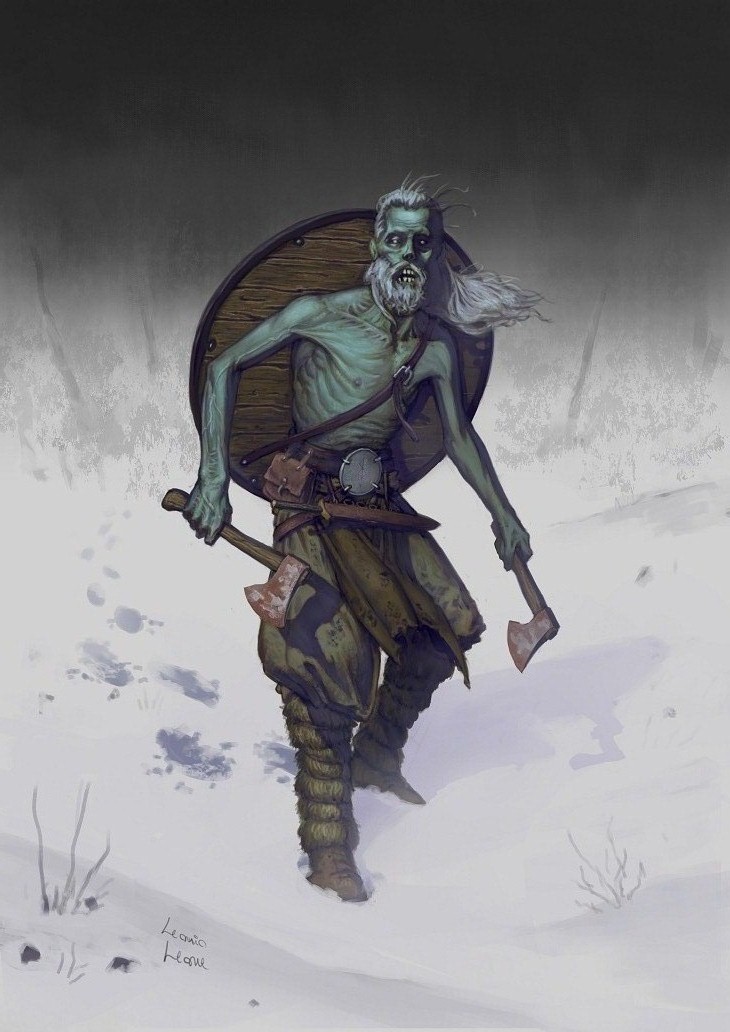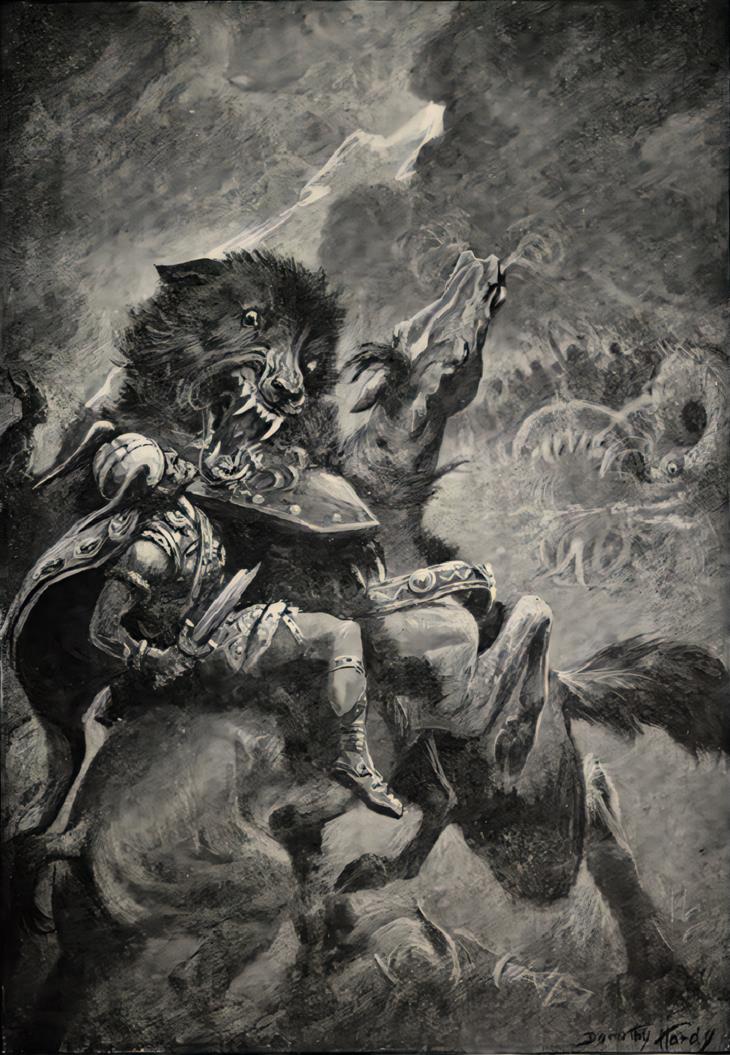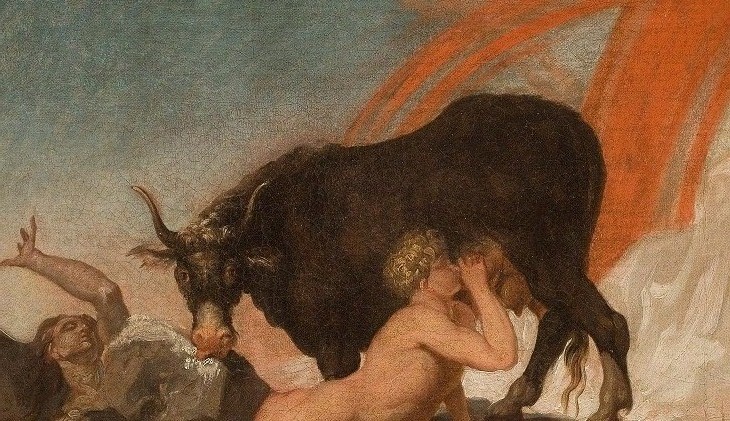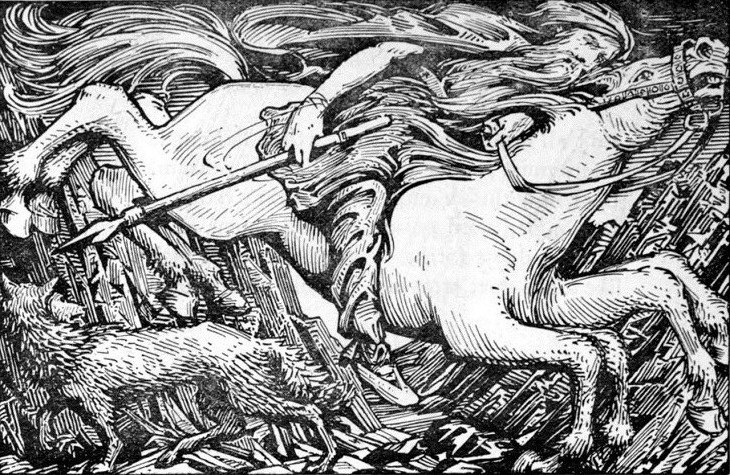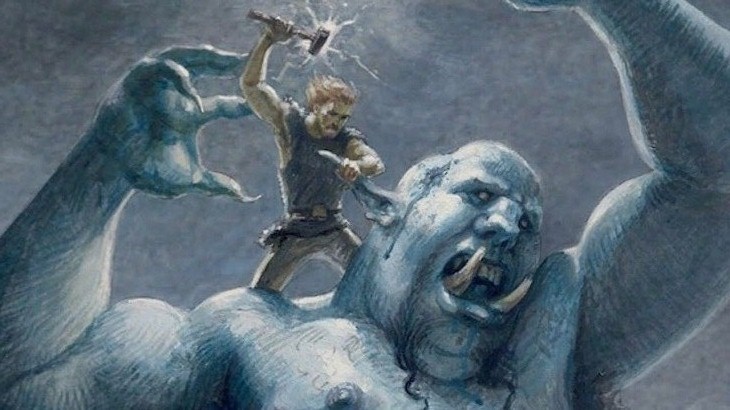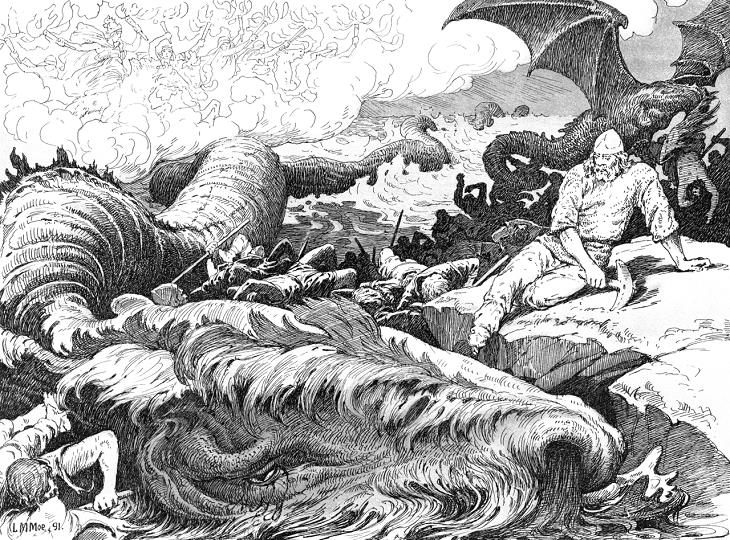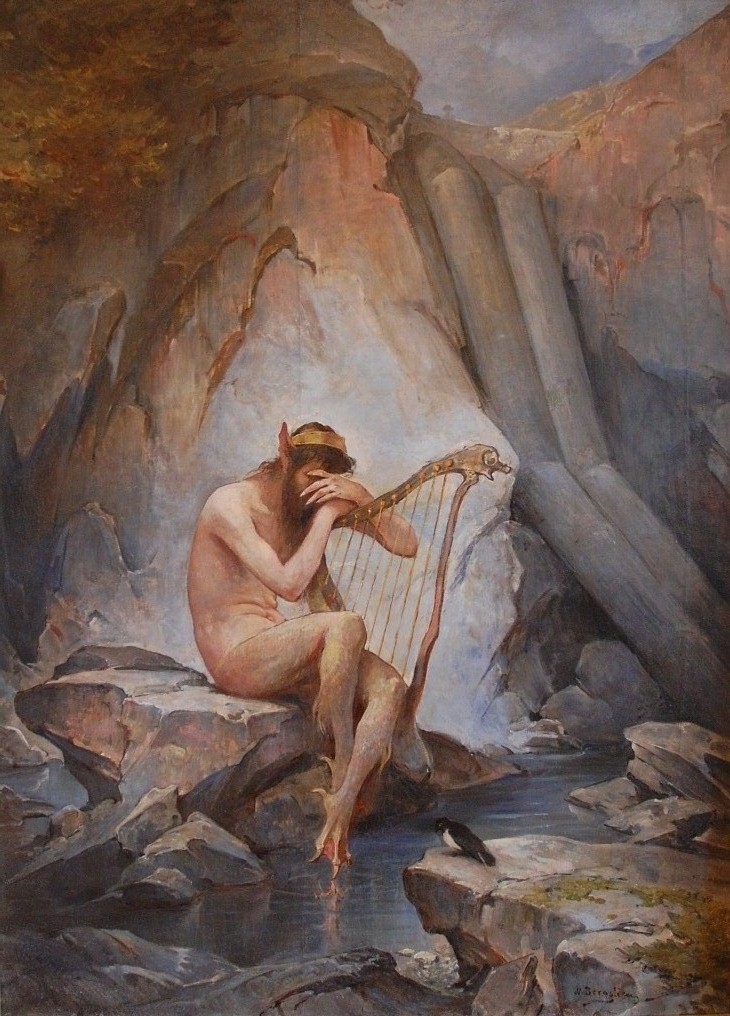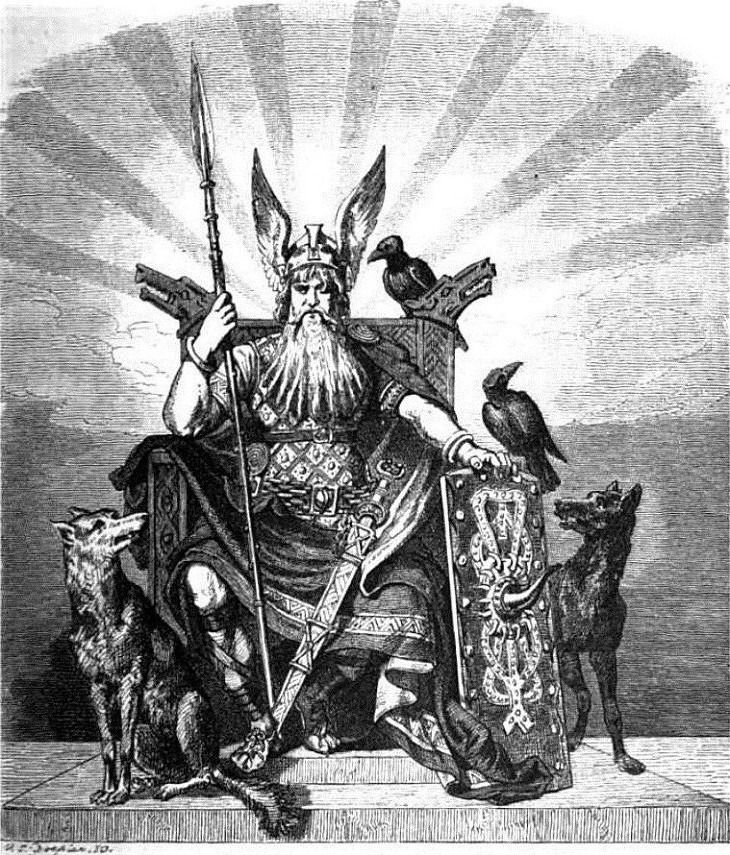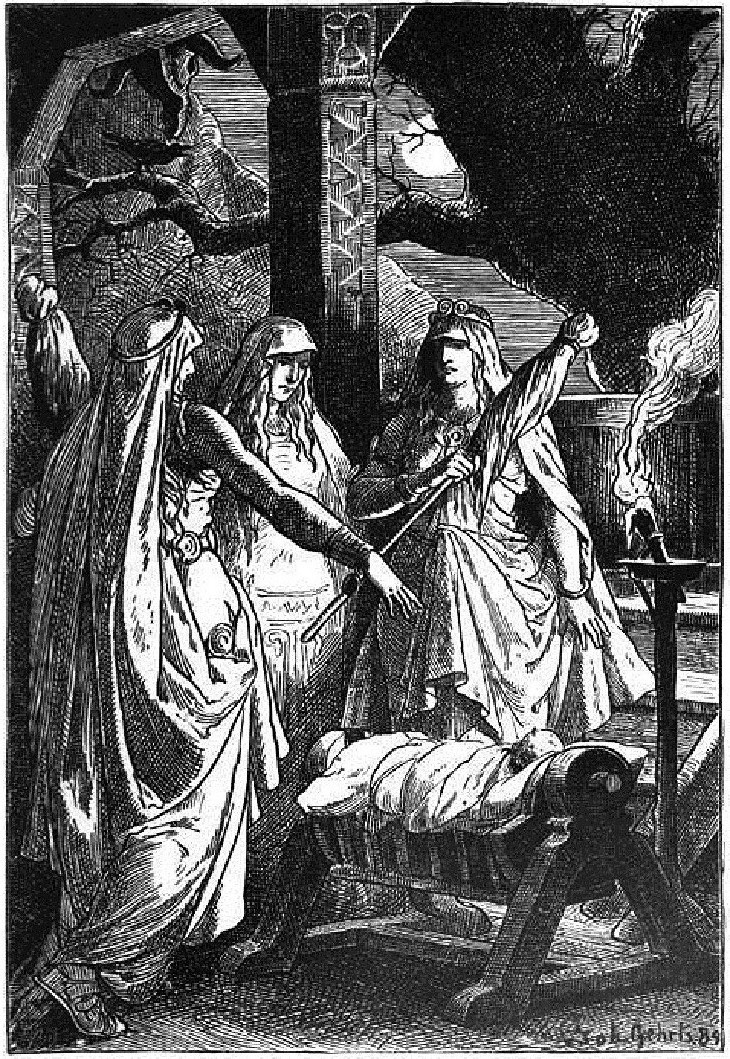A depiction of a Hulder talking with a charcoal burner. She looks like a young farmer woman, but her tail is peeking out under her skirt. From Svenska folksägner (Swedish folklore). Image source:
Wikimedia Commons
The Huldra, or Hulder, is a mystical being in Norse mythology that looks like an incredibly fair female and resides deep in the forest. Its name generally translates as “covered” or "secret." It has the tail of a cow, a hollow back, and wears a crown of flowers. Also called the "wardens of the forest," the Huldra are generally portrayed as malevolent beings who seduced young men and lured them into their dens deep inside the woods.
According to Norse myths, there is a whole race of Huldras living in the forests or the mountains. Curiously, when executing its seductive plan, the Huldra was known to have its cow's tail dangling from its dress. The potential victim was thus given the chance to recognize the danger and veer off the forest path.
2. Draugr
Draugr is a famous undead creature in Norse folklore. In contrast to zombies presented in contemporary popular culture, however, these creatures had superhuman strength, could increase in size at will and were capable of swallowing people whole. They were said to be the spirits of people who were evil, greedy, or sometimes just unpopular. Some versions also say that a Draugr is a warrior who lost his life on the battlefield. This creature dwelled in graves, guarding the valuable items buried with them. They were not, however, bound to their final resting place and could wander around the world.
The Norse Draugr could bite, infect and turn others into Draugar as well. They also spread diseases to humans and livestock, and their bite was thought to be the cause of several disease outbreaks.
3. Fenrir
One of the most famous wolves in world mythology, Fenrir is the offspring of the Norse god Loki and the giantess Angroboda. He is destined to kill Odin during the calamitous battle of Ragnarok and then be killed himself by Odin’s son Varr— the silent god of vengeance.
Fenrir was raised by the gods of Asgard. Since it was prophesied that the big wolf would kill Odin during Ragnarok, they chained him with special bindings. Fenrir was eventually able to free himself of his enchanted fetters and went on to fulfill his destiny.
While Fenrir is known as Odin's killer and the trigger of Ragnarok, he is not viewed as an evil creature. He was instead regarded as an inevitable part of life's natural order.
4. Audhumla
Ymir Suckling the Cow Audhumla by Nicolai Abildgaard (1777). Image source:
Wikimedia Commons
Audumbla was a beautiful primeval cow in Norse mythology. It’s said that four streams of milk ran from her udders, providing nourishment for the primordial frost giant Ymir. The cow herself was nourished by licking salty rime rocks. The first day she licked the blocks, a man's hair emerged from them. The second day, his head appeared. On the third day, Buri, the grandfather of Odin, was revealed. It's said that Audhumla was 'the noblest of cows' and is the only one mentioned by name.
5. The Kraken
The Kraken is a legendary sea creature from Norse mythology that is depicted as a massive squid or octopus. This monster is said to reside along Norway's shoreline. The Kraken, in its most popular form, is so immense that its ferociously large tentacles can drag down an entire ship. Several ancient Norse legends say that the Kraken's body was so enormous that it was frequently mistaken for an island.
In some Norwegian sea tales, the sea creature is described as a hybrid of an octopus and a crab. It has a serpentine head, large eyes, and a long mane resembling seaweed. Some claimed there was only one Kraken, but many others believed there were many that bred beneath the sea. In all likelihood, the Kraken was inspired by giant squids, which are capable of growing to enormous sizes.
6. Ratatoskr
Ratatoskr, or Drill-tooth, was a mythical squirrel who lived in the trunk of Yggdrasil, the sacred world tree that supported the various worlds of the Norse cosmos. This squirrel has sharp teeth and pointed ears and is mainly red.
Ratatoskr's responsibility was to act as a messenger between the eagles that soared above the tree and the serpents that lived at its roots. Mischievous and sly, he always embellished the messages of both parties in order to create misinformation between them.
Some legends say that the crafty squirrel’s ultimate goal was to bring down Yggdrasil. Since he lacked the strength to do this on his own, he manipulated the serpents and eagles so that they would fight and damage the world tree. Additionally, Ratatoskr used his drill-like teeth to wear down Yggdrasil over thousands of years to bring Ragnarok upon the gods of Asgard.
7. Sleipnir
Sleipnir is the eight-legged gray horse of Odin. He was the son of the celestial stallion Svadilfari and a mare that Loki shapeshifted into. In Norse mythology, Sleipnir is the symbol of power and speed. Known as the most magnificent horse in all the realms, he was a powerful steed with a stormy gray coat. Odin looked after him well and always rode him to battle.
Sleipnir could run as fast as light and fly when necessary. He was renowned for his extraordinary power and durability. Legend has it that this magical horse can go where other horses cannot.
8. Jötnar
The Jötnar (singular: jötunn) were a race of supernatural giants who lived in Jötunheimr (Jotunheim), one of Norse mythology's Nine Worlds linked by the Yggdrasil tree. They are constantly at odds with the mighty gods and are known to be enormous, with grotesque features. The Jötnar symbolize darkness and death and were instrumental in bringing about Ragnarök, the end of the world.
In Norse folklore, the world of these giant beings is described as cold and dark, which explains their hostile nature. However, not all Jötnar are enemies of the Norse gods. In some myths, they forge favorable alliances with them. Many Norse gods have children with Jötnar, and the majority of them have at least one Jötunn parent.
9. Jörmungandr
Drawing of Jörmungandr in the sea during Ragnarök by Norwegian artist Louis Moe from 1898. Image source:
Wikimedia Commons
Also known as the 'Midgard Serpent' or 'World Serpent', Jörmungandr was the brother of the wolf Fenrir, born to Angroboda and Loki. This giant serpent residing in the depths of the earth was prophesied to grow so large that he would encircle the entire world and grip his own tail. The Jörmungandr, according to legend, has the ability to grow or contract in size.
It was said that Ragnarok would begin after Jormungandr released his tail and come out of the ocean to poison the sky. Jormungand was also foretold to encounter Thor at Ragnarök, where the two would slay each other.
Prior to the Viking era, the concept of Jormungand was widespread in Germanic societies. Even early medieval Germans, it is believed, attributed natural phenomena, such as earthquakes, to the movement of the giant serpent.
10. Fossegrim
Water creatures are plentiful in Norse mythology, and the renowned Fossegrim are one of the most famous ones. A graceful and semi-clad water spirit, he plays captivating music on his violin and resides near rivers and waterfalls.
According to Norse myths, some of the malicious Fossegrims used music to lure women and children into the water, where they drowned. They are similar to the sirens of Greek mythology in this regard. In exchange for gifts, the Fossegrim often taught humans how to play the violin. These prominent 'gifts' include everything from live white goats to smoked mutton delicacies.
11. Huginn and Muninn
Carl Emil Doepler's 1882 painting depicts Odin seated on his throne and wielding his spear Gungnir, together with his ravens Huginn and Muninn and wolves Geri and Freki. Image source:
Wikimedia Commons
Huginn and Muninn, the two ravens of Odin, are frequently depicted on ancient Norse artifacts. Huginn (Old Norse for 'thought') and Muninn (Old Norse for 'mind') would fly around Midgard (the realm of men in Norse mythology) and bring news of men's affairs to Odin. The Norse god could keep an eye on his charges and grow wiser through their daily travels.
In some interpretations, the ravens represent Odin's intellect and spirituality. According to a few other theories, Odin was known to worry that one day the ravens would not return to him, and the ravens could have represented his casting out of his thoughts and his mind in a trance-like way.
12. Norns
The three Norns were a class of mythical beings with the power to weave and even control fate. The Norns were also in charge of looking after Yggdrasil. It was their responsibility to guard the tree by bringing water and fertile earth from the magical Well of Urd and pouring them on its branches. The ash tree would rot if they did not complete this daily task.
According to Snorri Sturluson's Prose Edda (a collection of Old Norse poems), the names of this trio of Norns are Urr, which means "what once was," Verandi, which means "what is coming into being," and Skuld, which means "what shall be," When an infant is born, the Norns are said to appear to determine how long the newborn should live. As they observe the child, the Norns will determine its lifespan and fate.
Share this post with all your loved ones...


